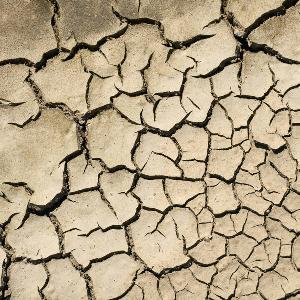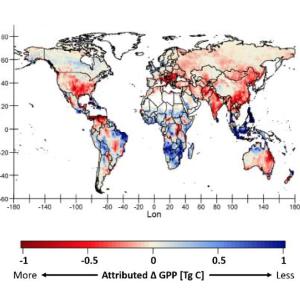Global plant growth is increasingly suffering from climate extremes
6 Aug 2021
Droughts and heatwaves that markedly impair plant productivity have become more frequent since the turn of the century.
6 Aug 2021
Droughts and heatwaves that markedly impair plant productivity have become more frequent since the turn of the century.

Climate extremes such as droughts and heat waves lead to lower plant growth. | © Imago
Plants absorb carbon dioxide from the ambient air and convert it into biomass. Episodes of extreme weather, such as droughts and heatwaves, decrease plant growth rates (primary production) and therefore reduce the amount of CO2 that can be extracted from the atmosphere. An international team of researchers led by Dr. David Gampe (who is affiliated with the Department of Physical Geography and Soil Science at LMU, and the Institute of Geography at Augsburg University) has now shown that, in particular in northern latitudes, the incidence of severe declines in plant growth increased by 10.6% during the period 2000-2016 relative to the average for the years 1982-1998.
The results indicate further that especially grass and agricultural land covers are becoming increasingly susceptible to particularly warm droughts and that the consequences are negative effects on the uptake of CO2 by plants and agricultural outputs.
Currently, around 50% of man-made annual CO2 emissions are absorbed in roughly equal proportions by land and oceans. In parallel with the rising CO2 emissions in the last few decades, these so-called land and ocean carbon sinks have also grown steadily, and have thus prevented an acceleration of climate change. However, more recent studies assume that these important carbon sinks will weaken in the coming decades, although there is still no consensus on the underlying mechanisms.
Plants play a crucial role in the land-based carbon sink, as they remove CO2 from the atmosphere through photosynthesis and bind it in the biomass. However, this important function of plants can be compromised by extreme weather events such as heat waves, droughts or heavy rain. A well-known example is the drought and heat wave that Europe experienced in 2003, during which plant growth decreased by 30 percent, cancelling the carbon sink of four years in this region.
The increasing evidence of more frequent and intense climatic extremes and the corresponding negative effects on ecosystems in the recent past raises the question of whether such shifts in climatic extremes have already led to a systematic reduction in plant growth at both regional and global levels.
The study evaluated the relationships between episodes of extreme weather events and reductions in plant growth rates over the period 1982-2016 based on the analysis of three datasets for gross primary production (GPP), which were obtained using distinctly different methodologies. The GPP describes the uptake of carbon by an ecosystem through photosynthesis, i.e. how strongly plants grow by absorbing CO2.
"In order to evaluate systematic shifts in gross primary production in response to observed changes in climatic extremes, the 1000 largest negative GPP extreme events were identified in the period from 1982 to 2016 and assigned to extreme climatic events," explains Gampe.
The key results indicate that the northern mid-latitudes in particular - including Europe among others - show a significant increase (10.6%) in negative GPP extremes between the periods examined. Regional hotspots are East Asia and Central North America. In addition, the study also finds that the months with exceptionally reduced plant growth due to GPP extremes have shifted from June/July to July/August, more towards the peak and later portion of the growing season. In the tropical regions, it is predominantly the Amazon region that shows a sharp increase in negative GPP extremes.
The majority of the identified extreme events of reduced plant growth (around 70% globally) can be attributed to climate extremes, which result directly from combinations of anomalous rainfall and temperature values. The remaining portion could have been caused by factors such as fire, pest infestation or wind, but these were not part of the study. The results showed that warm droughts in particular (characterized by coinciding water deficits and high temperatures) have increased significantly and are largely responsible for reduced plant growth in large parts of the northern hemisphere.

Changes in the impact of drought events on crop production in the period 2000-2016 compared to the period 1982 - 1998. Shown is the difference in negative extremes of CO2 uptake via photosynthesis ( BPP) due to drought events between the two periods. A drought-induced reduction in BPP is shown in shades of red. | © Gampe / LMU
Exceptional increases in negative extremes in gross primary production due to warm droughts were identified in the comparison period, especially for grasslands (increase of 95%) and croplands (+ 84%). They are more prone to drought than forested regions because these ecosystems generally do not possess the deep roots needed to reach water in the deeper soil layers. The study also shows that the negative impact of climate extremes on agricultural land can only be mitigated to a limited extent by management options such as irrigation.
The negative extremes of plant growth identified in the study counteract the general positive trend in global plant productivity (as an important component of the rising land-based carbon sink). The results of the study show that this actually positive GPP trend, which varies from region to region, has weakened considerably due to the increase in negative GPP extremes. In other words: Extreme weather events such as droughts lead to lower CO2 uptake, sometimes to the extent that the actually increasing productivity trend is weakened or stopped.
“Previous studies projected a sharp increase in negative GPP extremes by the end of the 21st century. The current study suggests that these adverse impacts of climate extremes and especially warm droughts on plant productivity are already ongoing” elaborates geographer Prof. Dr. Wolfgang Buermann, a co-author of the study. However, less plant productivity also means less CO2 uptake and thus a weakening of the land-based carbon sink, which further accelerates climate change. The fact that grasses and crop lands in particular are disproportionally impacted by climate extremes underscores the need for swift adaptation measures, especially given the current expansion in agricultural land. Fewer monocultures, better use of existing resources, different types of plants and social rethinking are strategies that can help the agricultural sector to better deal with the consequences of climate change. Uni Augsburg / LMU
David Gampe, Jakob Zscheischler, Markus Reichstein, Michael O’Sullivan, William K. Smith, Stephen Sitch and Wolfgang Buermann: Increasing impact of warm droughts on northern ecosystem productivity over recent decades, Nature Climate Change